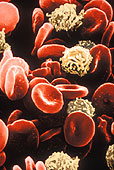
Blood cells
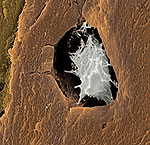
Bone cells
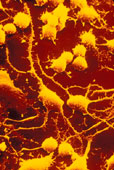
Nerve cells
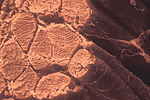
Skeletal muscle cells
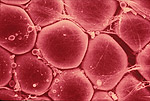
Fat cells
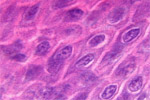
Skin cells
|
MOLECULAR & CELLULAR
NEUROBIOLOGY
Master Course Cognitive Neuroscience - Radboud
University, Nijmegen
|
|
|
|
Chapter 2: Cells and within cells |
|
|
Cells
|
At a microscopic level, living beings are made up of cells. A bacterium has only one cell, but humans have about 100 trillion. The 100 trillion cells may be one of about 200 different kinds, in different shapes and sizes. Each kind has its own role to play. Cells group together into different types of tissue, which in turn form organs and structures, like the heart. These organs work within systems, like the cardiovascular system, which allow the body to function. Muscles are made of muscle cells, and bones of bone cells. There are even very specialized types of cells for fingernails and each of the delicate parts of the eyes.
|
|
Blood cells |
 Bone cells |
Nerve cells |
 Skeletal muscle cells |
 Fat cells |
 Skin cells |
|
We have known about the existence of cells and have studied them for hundreds of years. As scientists developed ever more powerful and sophisticated magnifying devices, we have been able to look further into the features and behaviours of cells. Still, we do not completely understand all of their possible functions. It seems the more we study them, the more we discover about their organization and complexity. The cell is the basic unit of life. It is the smallest entity that can exist as an independent living system. The proper functioning of the body depends on what happens within the many different types of cells. Obviously, there are major differences between types of cells. Muscle cells, which can contract, have to be quite different from bone cells. Human nerve cells have long, thin fibres that may extend from the spinal cord to the toes, while blood cells have no projecting fibres at all. Plant cells have a unique ability to use light as a source of energy. Biologists make a distinction between cells based on how they are organized. Eukaryotic cells are more complex and highly structured, with membrane-bound 'organelles'. They include cells of protozoa, higher plants and animals. Prokaryotic cells are less structured and do not have membrane-bounded organelles. They include simple cells like bacteria. We can classify all living organisms according to five kingdoms: Animals, Plants, Fungi, Protoctista and Bacteria. Organisms in the first four kingdoms are eukaryotes, while bacteria are considered to be prokaryotes. Bacteria are the most numerous organisms on earth. Billions of them may be found in a handful of mud, or in the mouth. A single bacterium is a self-contained, living cell. Bacteria have no nuclear membrane, and so their genetic material is contained in a single circular molecule of DNA in the 'nucleoid' area. Protoctista is the catch-all category for organisms that do not quite fit into the other kingdoms. They are one-celled or multi-celled eukaryotes, with a nuclear membrane. Some of them, like amoeba, look like typical animal cells, but they are single-celled organisms. Others, like Euglena, have features of both animal and plant cells. Fungi must absorb their food molecules directly from other living or non-living organic sources. They usually have branching multicellular threads called hyphae that develop from spores. Plant cells have a nucleus, mitochondria, endoplasmic reticulum, ribosomes, Golgi apparatus and lysosomes, like animal cells. However, a plant cell is surrounded by a cell wall made of cellulose, which makes the cell more rigid. In addition, plant cells contain vacuoles that hold cell sap among other things, and chloroplasts, which contain the green pigment chlorophyll. Inside the chloroplasts, the process of photosynthesis takes place and the plant produces its own food. Animal cells have a nucleus, mitochondria, endoplasmic reticulum, ribosomes, Golgi apparatus and lysosomes. Unlike plant cells, they do not have chloroplasts, a cell wall nor a vacuole. Animal cells are surrounded only by a membrane, which allows the cell to be flexible and yielding. Of all organs the brain contains most cells, with the most abundant cell type being glia. See next page for more details on glia. |
|
|
|
| Next page: Neurons | Go back to: Introduction |
|
|